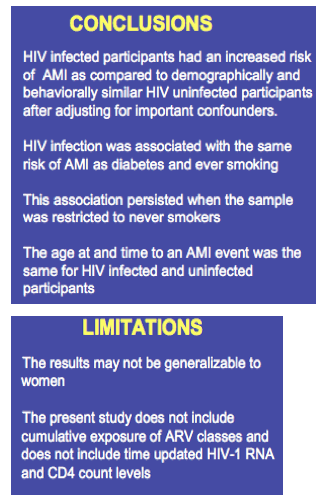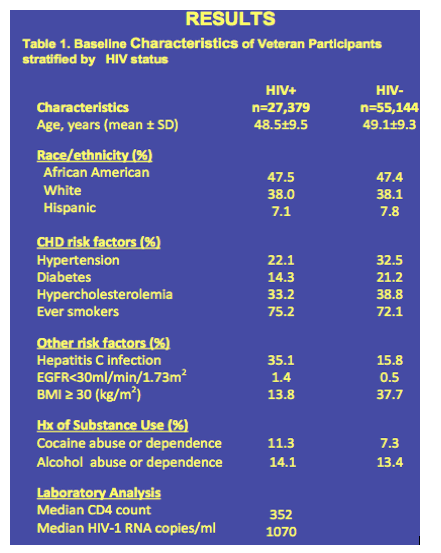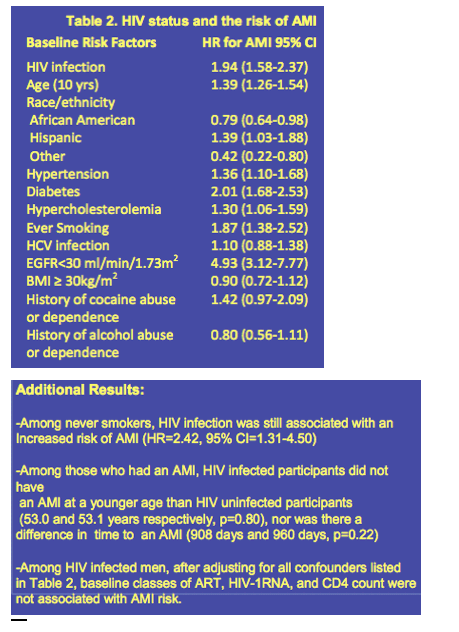 |
 |
 |
| |
HIV is Associated with Clinically Confirmed Myocardial Infarction after Adjustment for Smoking and Other Risk Factors
|
| |
| |
Reported by Jules Levin
CROI 2011 March 2 Boston
Matthew S. Freiberg,1 Kathy McGinnis,2 Adeel Butt,1 Matthew B. Goetz,3 Sheldon Brown,4 Kris Ann Oursler,5 Maria Rodriguez-Barradas,6 Cynthia Gibert,7 David, Rimland,8 and Amy C. Justice2,9
1 University of Pittsburgh School of Medicine, Pittsburgh, PA; 2 VA Connecticut Health Care System, West Haven Veterans Administration Medical Center; 3 David Geffen School of Medicine, UCLA and the VA Greater Los Angeles Health Care System, Los Angeles, CA; 4 James J. Peters VA, Bronx, NY, Mount Sinai School of Medicine, New York, NY; 5 Baltimore VA Medical Center, University of Maryland School of Medicine, Baltimore, MD; 6 Baylor College of Medicine and Michael E. DeBakey VA Medical Center, Houston, TX; 7 George Washington University School of Medicine and the Washington DC VAMC, Washington, D.C; 8 Emory University School of Medicine and Atlanta VAMC, Atlanta, GA; 9 Yale University School of Medicine, New Haven, CT

ABSTRACT
Background: While observational studies have reported an increased risk of myocardial infarctions (MI) among HIV-infected individuals, this association may be confounded due to differences in established risk factors among HIV+ and HIVŠ individuals. We compare the risk of MI among HIV+ and demographically and behaviorally similar uninfected veterans using proportional hazard models and adjudicated MI outcomes, adjusting for established risk factors.
Methods: We analyzed data on 81,229 veterans (33% HIV+) from the Veterans Aging Cohort Study Virtual Cohort (VACS), a sample of HIV-infected and 2:1 age, gender, race/ethnicity, and clinical site matched uninfected veterans. Variables included HIV status, age, race/ethnicity, hypertension, diabetes, alcohol and cocaine use, self-reported smoking, hepatitis C, lipids, CD4 count, HIV-1 RNA, class of ART and the incidence of MI from October 2003 to September 2008. All subjects were free of cardiovascular diseases at baseline. MI events were adjudicated as part of the Veterans' Administration Ischemic Heart Disease Quality Enhancement Research Initiative (IHD QUERI) using a standard protocol.
Results: During a median 4.6 years, there were 497 MI events (44% HIV+). Rates of MI were higher for HIV+ (21.7, 95%CI 19.0 to 24.7) per 10,000 person-years) than uninfected veterans (13.1, 95%CI 11.7 to 14.8 per 10,000 person-years), resulting in an increased relative risk of MI (HR 1.86, 95%CI 1.54 to 2.26) after adjusting for established risk factors including age (HR 1.04, 95%CI 1.03 to 1.05), Hispanic ethnicity (HR 1.35, 95%CI 1.01 to 1.80); hypertension (HR 1.40, 95%CI 1.15 to 1.70); hyperlipidemia (HR 1.29, 95%CI 1.07 to 1.56); diabetes (HR 2.06, 95%CI 1.69 to 2.50); and smoking (HR 1.48, 95%CI 1.14 to 1.93). Among HIV-infected participants, baseline CD4 counts, HIV-1 RNA levels, and class of ART were not associated with MI after adjustment for established risk factors (p >0.2).
Conclusions: HIV infection was associated with an increased risk of adjudicated MI events after adjusting for established risk factors among a cohort of HIV+ and demographically and behaviorally similar uninfected veterans. Future studies assessing the risk of MI among HIV-infected people will need to incorporate time updated CD4 counts, HIV-1 RNA levels, and duration of ART.
BACKGROUND
Whether HIV infection is in fact an independent risk factor for acute myocardial infarction (AMI) remains an important question. Prior studies reporting an association between HIV and AMI were typically limited by the lack of a demographically and behaviorally similar HIV uninfected referent group; clinically confirmed AMI outcomes; and or missing data involving important risk factors such as smoking and substance use and abuse.
The objective of this study was to determine whether HIV infection was an independent risk factor for AMI.
METHODS
Cohort:The Virtual Cohort (VC) is a cohort of HIV infected and age, gender, race/ethnicity, and clinical site matched HIV uninfected participants who were identified from United States Department of Veterans Affairs (VA) administrative data in the fiscal years 1998-2003 using a modified existing algorithm. This cohort consists of data from the clinical case registry; the VA HIV registry; the pharmacy benefits management database; the decision support system; the National Patient Care Database, and Health Factor data, which are data collected from physician clinical reminders within the VA electronic medical record system.
The Ischemic Heart Disease Quality Enhancement Research Initiative (IHD-QUERI) is a Veterans Affairs research initiative designed to improve the quality of care and health outcomes of veterans with ischemic heart disease. As part of this initiative, all participants from 2003 through 2008 , were reviewed in order to assess the system wide variations in acute coronary syndromes within the entire VA health care system.
Participants: 27,379 HIV+ and 55,144 HIV- participants from the VC who were free of baseline CVD in October of 2003.
Dependent variables: AMI was determined by the IHD QUERI. All suspected AMI events were clinically confirmed by trained staff after relevant clinical information including discharge summaries, other physician documentation, procedures note, laboratory testing, and other related health information was reviewed. AMI events include those presenting to the VA for care and those who initially presented to outside hospitals with an AMI and were subsequently transferred to the VA for additional treatment.
Independent Variables: HIV infection was defined as a participant with ≥ 1 inpatient and/or ≥ 2 outpatient International Classification of Diseases (ICD)-9 codes for HIV infection and confirmed by the participant's presence in the clinical case registry.
Covariates: Age, race/ethnicity, hypertension, diabetes, hypercholesterolemia, smoking, hepatitis C, renal disease, BMI, and history of cocaine abuse and dependence, and alcohol abuse and dependence. Systolic and diastolic blood pressures and lipid values were used in accordance with JNC VII and NCEP/ATP III guidelines, respectively, to assess hypertension and hypercholesterolemia.
Statistical Analysis: We assessed descriptive statistics for all variables by HIV status. Cox proportional hazard .models were used to estimate the hazard ratio (HR) and 95% confidence intervals (CI) to assess whether HIV
infection was an independent risk factor for incident AMI after adjusting for confounders. We calculated age and
race/ethnicity adjusted incident AMI per 10,000 person-years. We also compared, all traditional risk factors, important co-morbidities, and substance use and abuse by HIV status among those who experienced an incident AMI. Propensity score weighted Fine Gray models were used to assess competing risk of death.


|
| |
|
 |
 |
|
|